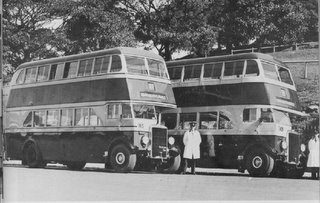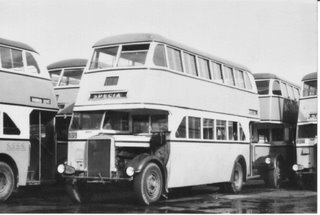
TWO LEYLAND TD4s, SO NEW THAT ONE OF THEM HAS NOT HAD ITS LINING-OUT COMPLETED, STAND IN THE DOMAIN, IN 1936. THEY ARE NOS 235 (m/o 1435), WITH GEARLESS TRANSMISSION, AND 229 WITH CRASH GEARBOX, BOTH WADDINGTON STEEL FRAME BODIES. 235 later had the troublesome gearless transmission removed and a crash box fitted; it went on to survive in service until 1961.
By 1937 the New South Wales Department of Road Transport and Tramways was really getting into its stride as a bus operator. The Department was formed in 1933 to compulsorily acquire many private bus firms and combine the operation of tramways in several cities throughout the state, and buses in Sydney and Newcastle.
A ragbag of routes and vehicles was taken over and immediately the hunt was on for a suitable standard vehicle design to handle large passenger loadings. Most of the private operators' buses had been single deckers, many of US origin, but a double decker was chosen as the basis of planning. The first examples for the DRTT had wood framed bodies, but these rapidly disintegrated under the severe strains of less than perfect road surfaces, hilly terrain and heavy loads, so steel framing was tried and after a couple of experimental designs the body style used on my Leyland was made the standard.

LEYLAND TD4 NUMBER 266 IN THE DRTT FLEET HEADS TWO TD3s WITH WOOD FRAMED BODIES BY SYDWOOD OF BANKSTOWN NSW. PHOTO ca 1937, ON THE VISIT OF THE ADELAIDE BOYS BAND TO SYDNEY.

THREE TD4 LEYLANDS HEADED BY FLEET NUMBER 213. THE FIRST TWO BUSES HAVE EARLY CLYDE ENGINEERING METAL FRAMED BODIES, WHICH DO NOT HAVE THE DISTINCTIVE TRIANGULAR WINDOWS HIDING DIAGONAL BRACING. THE THIRD BUS HAS VERSION THREE OF THE STEEL BODY, BY WADDINGTONS LTD, CAMPERDOWN NSW. IT HAS ROUNDED EDGES TO THE TOP DECK, FRONT

THESE TWO PHOTOS SHOW THE SECOND ATTEMPT AT A STEEL FRAMED DESIGN, BY WADDINGTON, WITH ITS DISTINCTIVE HARD-EDGED CORNERS AT THE FRONT OF THE TOP DECK

THIS SURVIVOR IS A TD4, FLEET NUMBER 238 AND IS SCHEDULED TO BE RECOVERED FROM A SITE IN QUEENSLAND

A SNAP FROM THE FAMILY ALBUM. MY FATHER-IN-LAW WAS AN ARMY OFFICER WITH RESPONSIBILITY FOR SCHOOL CADETS. A GROUP OF ELDERLY EX-GOVERNMENT BUSES OWNED BY WEST BANKTOWN BUS SERVICE AND HEADED BY A LOWBRIDGE-BODIED TD4 DELIVERS CADETS TO CAMP, PROBABLY INGLEBURN, IN 1956. THE SECOND BUS, THEN M/O 691, WAS m/o 1229 IN DRTT SERVICE AND CARRIES THE FIRST WADDINGTON STEEL FRAMED BODY. photo Mrs R. Rodd.
Large orders for hundreds of bus chasses were placed with British manufacturers under the encouragement of Empire Preference trade agreements. Suppliers included AEC (Associated Equipment Company, London) Leyland Motors Ltd. in Lancashire, and Albion Motors in Glasgow. From 1935 onwards until the Second World War halted production, almost all were bodied by The Waddington Motor Body Co of Camperdown, Sydney. By mid-1937 pressure on production facilities had grown such that this company established a large new factory on a greenfield site at Granville NSW near Parramatta.

A NEWLY COMPLETED LEYLAND TD5 AT THE NEW GRANVILLE SITE, POSSIBLY THE FIRST OFF THE NEW PRODUCTION LINE

TWO VERY TIRED OLD LEYLAND TD4s WAIT FOR DUTY AT GORDON AVENUE DEPOT HAMILTON IN NEWCASTLE. M/O 1375 IS IDENTICAL TO 1379, AND 1408 MAY BE ONE OF THE LAST BODIES BUILT AT WADDINGTONS' CAMPERDOWN WORKS.

THE SUBJECT OF RESTORATION: FLEET NUMBER 379 PHOTOGRAPHED IN YORK STREET CITY IN 1938, BARELY ONE YEAR INTO SERVICE, HAVING JUST COMPLETED A RUN FROM NORTHBRIDGE ON ROUTE 2 (NOW ROUTE 202)
Now, some explanation is needed of the disparity between the fleet number and the registration numbers of the buses above.
In 1933 the registration numbers m/o 001 to m/o 1000 were set aside for buses belonging to private operators. DRTT registrations began at m/o 1001, carried at that date by a Leyland TD1 bearing fleet number 1. However private bus numbers soon swelled and a further 200 m/o plates were reserved to them, so that DRTT numbers were revised to begin at m/o 1201.
Thus, until late 1939, DRTT registration numbers were always 1200 above the fleet number. However this anomaly was resolved by simply making the registration number equal to the fleet number plus one thousand, a system which applies to this day for STA (State Transit Authority) buses.
And so in the both above photographs, dating from prior to 1939, m/o plate numbers are 1200 above the fleet number. By 1940, my Leyland, 379, had become m/o 1379, a registration it carried until eventual sale in 1963.

MY LEYLAND AT THE HEAD OF A NUMBER OF BUSES QUEUED IN BARTON ST CIRCULAR QUAY TO OPERATE A 'TRAMLESS SUNDAY' IN 1948. BY THIS DATE TRAMS WERE ON THEIR WAY OUT AND EFFORTS WERE MADE TO SAVE COSTS BY USING BUSES WHEN PATRONAGE WAS LOW. photo Vic Hayes

November 2006 update: ANOTHER PICTURE RECENTLY RECEIVED OF 1379 STILL IN SERVICE IN ABOUT 1960, IN ITS ROLE AS DRIVER TRAINER AT BURWOOD DEPOT. BEHIND IT TO THE RIGHT IS m/o 1244, AN EVEN OLDER TD4. photo DAVID TAYLOR
Interestingly, and showing the endearingly haphazard approach of the DRTT to bus maintenance, 1244 has its front air vent still in the original, higher, position which it occupied when the offside headlamp was mounted in the front scuttle. This feature has been restored in 1379.
No comments:
Post a Comment